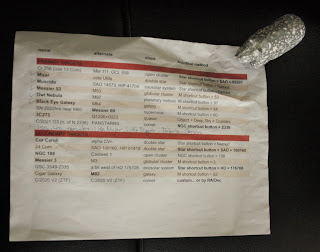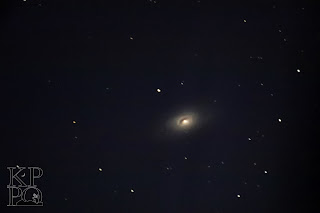Day 16 blog entry.
Tuesday 24 May 2022 - Beginning of the Final Week
Woke early. My sleep shifting is definitely not working. Observed some wispy clouds but it was trying to be sunny. The windsock was down: zero knots.
Discovered a message in my inbox from the night before. Missed it. A RASC member was looking for some technical support with TheSkyX and a Paramount MyT. Sounded like a cabling problem. "It's always the wire." I looped in others to see if someone had more ideas.
8:03 AM. Our woodpecker friend is back. Sending signals again. Was able to get a fuzzy photo of the little rascal.
... . -. -.. / -- --- .-. . / ... .- .--.
Worked on a target list for the evening. Some Messiers, a couple of unusual things, a double star of course, a few combo unaided eye-telescope things. Made up a worksheet for the telescope operator.
Weird. The Clear Sky Chart for Killarney had not updated. It's a couple of days old now. Astrospheric is working fortunately. Looks good according to Environment Canada.
I looked up the evening's best flyover of the International Space Station. And who's on board right now: Korsakov, Artemyev, Matveev from Roscosmos; Lindgren, Hines, and Watkins from NASA; Cristoforetti from ESA; and crash test dummy Rosie the Rocketeer from Boeing. It is very interesting that there are many spacecraft docked to ISS: the brand new Boeing Starliner; SpaceX Dragon; and a couple of Soyuz.
Did a bunch of prep at the dome! For the show for the park visitors as well as my next wide-field imaging run.
Had a go at trying to fix the finder scope illuminator on the 10-inch telescope but it uses some peculiar coin batteries which I don't have.
Received a confirmation that I'm on the docket for a presentation at the Royal Astronomical Society of Canada General Assembly. I'll talk about how amateur astronomers can perform citizen science on double stars, contributing to our body of knowledge on star formation and stellar distances.
Brianna sent me a YouTube link on an interesting piece on time. I look forward to viewing it. We like these brain benders.
3:29 PM. Started receiving Clear Sky Alarm Clock alerts for some of my other favourite observing sites around the province. A good sign, in general.
Updated the imaging document with some information on the Fire Capture software.
Dinner: pork chops with a secret recipe rub.
I thought the skies were improving. Yeh! Wispy clouds kill galaxies.
Huh. Tried to find it but the old NRC magnetic declination calculator is gone! Used a different web site instead. It's roughly -9.5°. Note the negative, meaning west.
https://www.magnetic-declination.com/
At 9:30 PM, we ran another Tour of the Night Sky. But this time, without clouds! And it was a fantastic event!
Apologised for the lack of planets. But for the early morning people, I encouraged them to check out the very nice grouping before dawn, over the next couple of days with the Moon passing Mars, Jupiter, and Venus. Showed a simulated view in Stellarium Mobile Plus.
We shared live views and photographs from the telescope. Sky was bright at the start but we viewed Arcturus with our eyes and on the camera. Then we checked out the neat double star system in Ursa Major: Mizar, Alcor, Mizar A and B. We ruminated on the exosolar system Muscida, a naked-eye star with known exoplanets.
Messier 53, a globular cluster, looked wonderful with a long exposure.
The Owl Nebula was green! A very interesting planetary nebula.
Finally, we enjoyed the Black Eye Galaxy with its curious dark features.
We found the North Star aka Polaris using the Big Dipper. We tagged the constellations Leo, Ursa Major, Lyra, Cygnus, and Corvus. And that Big Dipper also marks the locaiton of The Fischer Hero. Kathleen flew the 16 aided by Kate. Everything worked and I was very pleased with how things looked. Oh, and we saw the ISS flyover.
Whew!
Fun!
The Astronomer-In-Residence program is coordinated by the Allan I Carswell Observatory (AICO) at York University with the Killarney Provincial Park Observatory (KPPO).






No comments:
Post a Comment